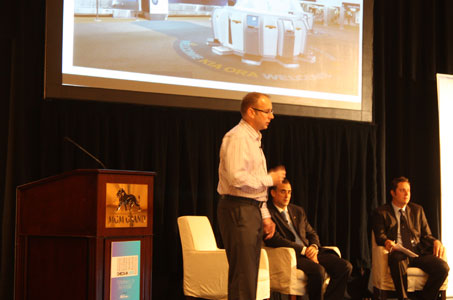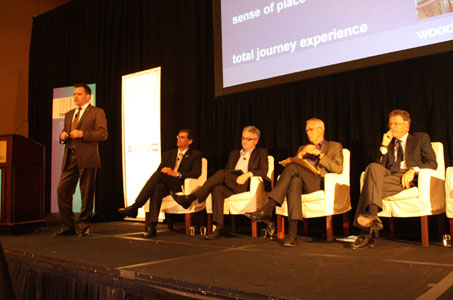Themed ‘Terminals of the Future’, the conference examined how check-in practices will evolve in the long-term and what impact this will have on systems and facilities. The keynote addresses were delivered by Juan Trescastro, VP worldwide port operations, Royal Caribbean Cruises, and Todd Grace, strategy manager – airports, Air New Zealand. Trescastro provided a fascinating insight into the check-in and baggage challenges associated with operating the world’s largest passenger vessel – the recently inaugurated ‘Oasis of the Seas’ cruise ship.
Royal Caribbean Cruises has created an innovative check-in experience to match its incredible ship. Its commitment to guests is that they will transfer from curb to gangway in 15 minutes. An intuitive and simple luggage sortation system has been developed, with immediate sorting on receipt of luggage. The statistics are impressive, with 12,400 embarking/disembarking guests and 18,000-20,000 loaded/offloaded bags. Trescastro explained that future projects will include remote check-in utilising an all-in-one handheld device at the airport, hotel or pier curbside, true paperless check-in, and exclusive self-service check-in for loyalty members.
Grace highlighted the Air New Zealand experience of the role of self-service in the airport. “The writing is very clearly on the wall that the days of the traditional check-in experience are numbered. I believe that most airlines should be past the stage of thinking about if they need a self-service strategy, but rather how they go about designing and implementing one,” he said.

The Air New Zealand experience is that if you offer travellers a solution that is intuitive and provides benefits in terms of time and choice, they will embrace that new service. “Within a few months we quickly began to see the other benefits that flowed from a successful self-service strategy. In addition to the benefits brought by having increased customer satisfaction we saw more productive use of terminal space, greater efficiencies in resource allocation and planning, greater engagement by airport staff, as well as a positive effect on brand awareness for the airline,” said Grace. The airline has varying degrees of automation at its airports, with the domestic terminal at Auckland being the purest self-service experience.
Airline perspective
There was strong airline representation on the conference programme. Patrice Ouellette, director, customer solutions & innovations, Air Canada, outlined the potential applications for Near Field Communications (NFC), which could provide a technology platform for greater self-service opportunities and deliver more personalised requirements, in a faster, more interactive way. NFC can provide fast transaction time, high security and convenience.
Jared Miller, managing director – self-service & emerging technology, Continental Airlines, focused on mobile technologies and the ways in which they are used to interact with passengers.
Meanwhile, Philip Wagnert, director product strategy and development, SAS Scandinavian Airlines, provided an airline perspective on speeding passengers through the airport. The SAS strategy centres on ‘service and simplicity’ throughout the travel chain. “We promise to minimise your time related to travelling and we promise to maximise your value of the time spent with us.”
Wagnert highlighted four key steps in terms of self-service: Self-service bag drop, self-service arrivals baggage kiosks, self-service payment for excess baggage, and personal permanent bag tags – “the question now is how we can make a universal inter-airline solution for the future, without having to change the entire baggage handling infrastructure”.
Security and facilitation
Security and facilitation innovations were explored in some detail. Paul Mewett, director, passenger processing, Vancouver Airport Authority (host of next year’s rebranded ‘Future Travel Experience’), provided a fascinating insight into the airport’s experiences of Automated Border Clearance. He explained that there is a two-year MoU to build and deploy Automated Border Clearance, which in the initial pilot is for Canadian residents only. There are currently 12 kiosks and it operates 24 hours a day, 7 days a week.
Sean Farrell, portfolio director, Biometrics Center of Excellence, SITA, followed with a presentation on the significance of biometrics to future processes. In a truly enlightening address, he explained that migration to off-airport check-in is already well underway. “The long-term ambition is to eliminate check-in at the counter for frequent travellers and eventually everyone,” he said. “But bags still need to be checked and airlines need to know when and where their passengers are at the airport.”
Boarding passes will be replaced by secure e-Tokens, which establish identity and ‘right to fly’ – Farrell gave the examples of barcode, cell phone, frequent or registered traveller smartcard, and ePassport. These could be re-usable or single-use and ideally linked to a biometric to enable secure multi-factor identity verification. Self-service bag drop is also on the rise. “Passenger queues have moved from check-in to bag drop. e-Tokens and biometric identity checks are key enablers of self-service bag drop. In the future, passengers will use home printed and/or permanent electronic bag tags linked to our e-Tokens,” said Farrell. Self-service boarding will also become more widespread, with the boarding process simplified to e-Token, e-Token plus biometric, or eventually biometric only.

What the ‘Terminal of the Future’ will actually look like was addressed by Philip Mein, principal emeritus, Corgan Associates, Inc, and principal investigator on the Transportation Research Board’s “Innovations for Airport Terminal Facilities” Report, and David Holm, transport portfolio leader and principal, Woodhead.
The baggage challenge was also explored, with a focus on advancements such as express baggage drop-off, offsite, self tagging, baggage reflight, and home printed or electronic bag tags.
Overall, Check-in 2010 provided a comprehensive insight into the technologies and processes that will impact on the ‘Terminals of the Future’. The rebranded ‘Future Travel Experience’ event will take place in Vancouver, September 7-9 2011.
Here are the views from some of the delegates who attended Check-In 2010
A.E. ‘Chip’ Houk, Manager Airport Systems, Delta:
“The conference was excellent with very engaging speaker panels. I was particularly interested in the sessions on mobile technologies. The overall event is fantastic because it brings vendors together with customers. I highly recommend it.”
Marc Michel, General Manager – Services & Solutions, BCS:
“The Check-In show is the epicentre of the self-service revolution. We have been speaking with various airlines here. As a vendor, it’s a great opportunity to get up to speed with developments worldwide. It’s my first time attending the event and I will certainly be at Check-In Asia as well.”
Ronald Kennedy, Project Planner, Aviation Planning, Seattle-Tacoma International Airport:
“This event is an opportunity to get a sense of what the new technologies are and how we can implement them into our airport. We are currently looking at new technologies that can help us make efficient use of space in the airport. The Air New Zealand presentation on the role of self-service in the airport was one of the most interesting I’ve seen and I’m excited to go back and download many of the presentations. New technologies will affect how we plan airports in the future. I really like the fact that the event is expanding next year to reflect the total passenger travel experience of the future.”
Justin Taubman, Project Manager of Passenger Innovation, TSA:
“The conference sessions have been incredibly stimulating. I particularly enjoyed the focus on IATA’s Fast Travel initiative. The networking aspect of the event has brought everyone closer together. During the Happy Hour and coffee breaks everyone has been talking about the subjects raised in the conference sessions. The event is undoubtedly a great networking opportunity for people in the industry. It is one of the few opportunities where vendors, airlines, airports and government are in the same room together, talking about the future of the industry.”
Jared Miller, Managing Director Self-Service & Emerging Technology Marketing Programs, Continental Airlines:
“As in all previous years, the event has provided a tremendous dialogue between industry stakeholders. It has been exciting to watch the show grow with new airports, airlines and vendors bringing new ideas to improve the travel experience. I am certainly looking forward to the Future Travel Experience event in Vancouver next year. The conference presentations have been thought-provoking and the dialogue with the audience after each session is testament to that. It’s nice to see presentations that are very much forward-thinking.”
Crystal Ditch, Trade Show/Events Coordinator Brand Management & Communications, ARINC:
“This is a very targeted show for us. All of the customers we needed to see are here. It is very important and beneficial to us to participate here each year. All of our current customers are here and the right people – the decision-makers – are here.”
Kurt Bakken, CUPPS Technical Analyst, Airport Information Technology, Edmonton International Airport:
“The event is very informative, particularly regarding common use from both an airport and airline perspective. We’re in the midst of revamping the infrastructure systems at our airport, so the event has been very useful. I found the architecture session very interesting, which offered a different perspective, as being an airport we’re always concerned with the well-being of our passengers. It was also interesting to hear about self-tagging, which has been implemented at Edmonton for a while.”
Mike Chew, Director Airport Services & Reservations Products & Services, Star Alliance:
“It is a very well-organised conference and the presentations have been very informative. I agree with the name change to Future Travel Experience, which is very timely and more relevant to the industry and the way it’s moving. The event also provides the opportunity for lots of good networking. I was particularly interested in the self-service baggage aspects of the conference. At Star Alliance, we are looking at how to optimise space and commonality – how we achieve synergies and commonality. Common bag drop and offsite check-in and bag drop are very relevant to us.”
Rob Chan, Practice Leader eAccess Solutions, Customer Facing Solutions, IBM:
“This show is a great opportunity to meet not only with our existing clients, but new ones as well.”






